I’d be willing to bet that anyone who was over the age of five on September 11, 2001 remembers exactly where they were and what they were doing that morning. I was alone in my apartment and, when I awoke, something made me click on the TV set in my room. I tuned in just before the second plane hit the tower.
I called my friend, Marge, a native of New York City, and got her answering machine. I yelled loudly into the receiver for her to turn on her television in hopes that she’d hear me on her recorder. She didn’t answer and I hung up and continued to sit, watching in stunned silence. When she finally called back, she was sobbing. I can still hear her voice and the anguish therein. Hers echoed the sound of America that day and for weeks to come.
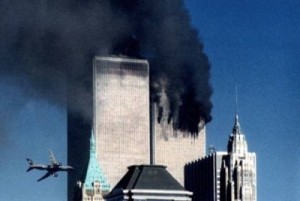 That morning we watched in horror and for weeks and months to come we replayed it in our minds and on TV screens. And as the weeks passed, the details began to emerge of how and why. Fingers were pointed and the drums of war were beaten.
That morning we watched in horror and for weeks and months to come we replayed it in our minds and on TV screens. And as the weeks passed, the details began to emerge of how and why. Fingers were pointed and the drums of war were beaten.
But there also began to emerge the stories of individuals, stories of personal sacrifice and heroism. Articles and books were written and films were made about some of the lives that were lost, saved and changed that day. Tears came and came again. The city was filled with millions of individuals, who had scurried to live their frantic lives, never having a moment to even acknowledge a passing stranger. Now they walked the streets of a stunned city and looked each other in the eye as they passed, each asking the silent question, “Brother or sister, are you OK?”
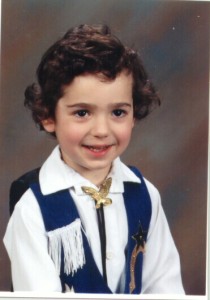 A few months following the attacks I was saying goodnight to my four-year-old. I realized the extent of my buried rage when he sat up in bed, refusing to lie down.
A few months following the attacks I was saying goodnight to my four-year-old. I realized the extent of my buried rage when he sat up in bed, refusing to lie down.
“What’s wrong?” I soothed.
I can still see the way he held up his tiny hand, palm down and motioned with it. “I’m afraid an airplane is going to crash into my house…”
He hadn’t seen the actual event, but it was played over and over on every TV in the nation. And he’d seen it and felt the nation’s anguish and now the fear was within him. Those bastards had touched my innocent child.
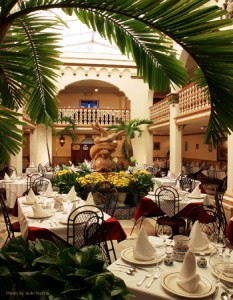 One morning we were at breakfast in the San Fernando Valley and there on the patio was the regular piano player who, every Sunday, serenaded the diners with soft hits and standards. Without warning or fanfare he quietly sang God Bless America. A Basketball-sized lump immediately formed in my throat and I set down my fork, knowing that no food would pass this painful protuberance. Tears began to form in my eyes and, in an attempt to stop them without wiping them away, I turned my head away. Across the patio, glimmering from the sunlit silverware and crystal, I saw everyone else slowly putting down their utensils. Each person sat in silence, their heads slightly bowed, each looking past their unfinished meals to some memory.
One morning we were at breakfast in the San Fernando Valley and there on the patio was the regular piano player who, every Sunday, serenaded the diners with soft hits and standards. Without warning or fanfare he quietly sang God Bless America. A Basketball-sized lump immediately formed in my throat and I set down my fork, knowing that no food would pass this painful protuberance. Tears began to form in my eyes and, in an attempt to stop them without wiping them away, I turned my head away. Across the patio, glimmering from the sunlit silverware and crystal, I saw everyone else slowly putting down their utensils. Each person sat in silence, their heads slightly bowed, each looking past their unfinished meals to some memory.
God Bless America… My home sweet home… His clear voice resonated upon the surrounding walls and columns. God Bless America… My home sweet home… He gently finished his song, quietly closed the cover on his keyboard and slowly walked away for his break. His footsteps and a few sniffles were the only sounds to be heard in that plaza.
Slowly, people wiped an eye or blew their nose. And we tentatively began to pick up our utensils and get on with our breakfast as the rest of the nation would falteringly pick up the pieces of our lives and get back to living them. The first steps were uncertain and tender; the discomfort and hesitancy at returning to normalcy as painful as those first swallows of food squeezing past the lumps in our throats.
Healing Begins
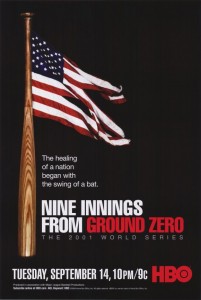 For the people of New York City, the three games the Yankees played at home in the 2001 World Series—a series that would ultimately conclude in a heart-wrenching loss in the bottom of the ninth in game seven—did more than could be explained to buoy the spirits of a devastated city. An HBO documentary called Nine Innings from Ground Zero was made about that Series and the impact it had on the people of New York. I own a copy and it took a few years and about a dozen viewings before I could watch it without crying when they showed rescue workers pausing amidst the rubble to ask the score of the game or sitting down for a moment to root for their home town team as the Yankees made three miraculous come-from-behind wins.
For the people of New York City, the three games the Yankees played at home in the 2001 World Series—a series that would ultimately conclude in a heart-wrenching loss in the bottom of the ninth in game seven—did more than could be explained to buoy the spirits of a devastated city. An HBO documentary called Nine Innings from Ground Zero was made about that Series and the impact it had on the people of New York. I own a copy and it took a few years and about a dozen viewings before I could watch it without crying when they showed rescue workers pausing amidst the rubble to ask the score of the game or sitting down for a moment to root for their home town team as the Yankees made three miraculous come-from-behind wins.
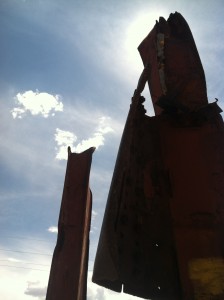 All around the nation we did what we could to commemorate the tragic events that occurred that day in the skies and streets of New York, inside the walls of The Pentagon and in a field in Pennsylvania. The town of Winslow, Arizona erected a memorial on the first anniversary of the attacks. The memorial took the efforts of many and the dedication of two WalMart drivers (selected from 169 volunteers) who drove night and day to deliver two of the largest pieces of the towers to be donated by Emergency Management on Staten Island. They arrived back in Winslow just five days before the first anniversary and the dedication of their memorial. The full story can be read here.
All around the nation we did what we could to commemorate the tragic events that occurred that day in the skies and streets of New York, inside the walls of The Pentagon and in a field in Pennsylvania. The town of Winslow, Arizona erected a memorial on the first anniversary of the attacks. The memorial took the efforts of many and the dedication of two WalMart drivers (selected from 169 volunteers) who drove night and day to deliver two of the largest pieces of the towers to be donated by Emergency Management on Staten Island. They arrived back in Winslow just five days before the first anniversary and the dedication of their memorial. The full story can be read here.
A Decade Later
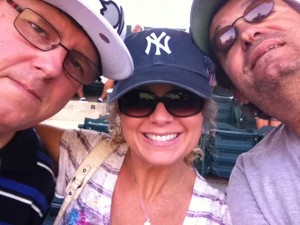 On the tenth anniversary, I was the guest of my friend, Vic, to Anaheim Stadium for a game between the Angels and Yankees. The pregame ceremonies included approximately 100 first responders and six men who were first responders to the Twin Towers on 9/11. A monstrous flag was unfurled in center field, held by all of the guest first responders during our National Anthem.
On the tenth anniversary, I was the guest of my friend, Vic, to Anaheim Stadium for a game between the Angels and Yankees. The pregame ceremonies included approximately 100 first responders and six men who were first responders to the Twin Towers on 9/11. A monstrous flag was unfurled in center field, held by all of the guest first responders during our National Anthem.
The Los Angeles Angels of Anaheim paid tribute to the Yankees and people of New York that day by inviting Joe Torre—Executive VP of Baseball Operations for MLB and manager of the Yankees on the day of the attacks—to the field.
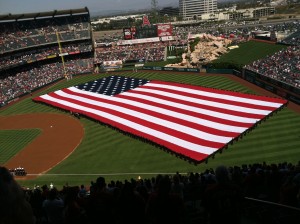 For the ceremonial first pitch, they invited to the field the three remaining Yankees players who were with the team back then, Derek Jeter, Jorge Posada and Mariano Rivera. The Angels players joining them were Torii Hunter, Mike Scioscia and Jared Weaver. Throwing out the first pitch(es) were the six first responders who were at the Towers that morning. Each man was introduced to thunderous applause and then they all tossed their baseball to one of the players. Immediately the players stepped to the
For the ceremonial first pitch, they invited to the field the three remaining Yankees players who were with the team back then, Derek Jeter, Jorge Posada and Mariano Rivera. The Angels players joining them were Torii Hunter, Mike Scioscia and Jared Weaver. Throwing out the first pitch(es) were the six first responders who were at the Towers that morning. Each man was introduced to thunderous applause and then they all tossed their baseball to one of the players. Immediately the players stepped to the 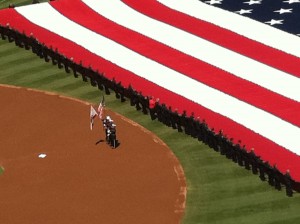 men and handed back the baseball. Pens appeared and the first responders asked their respective counterpart for an autograph. The balls were then handed to the next player so the men could get a ball with all six signatures.
men and handed back the baseball. Pens appeared and the first responders asked their respective counterpart for an autograph. The balls were then handed to the next player so the men could get a ball with all six signatures.
A lump again grew in my throat as, at the next moment, six more baseballs materialized and the players asked for a signature from each of the first responders. It was such a loving and honorable tribute to those men and all of our first responders around the country; baseball heroes paying homage to real heroes.
On that day, ten years later, there were more tears of remembrance, but it was also one more step in the healing process.
Seeing the Good
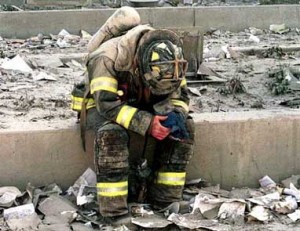 On the tenth anniversary, there were more documentaries made to commemorate that day a decade prior. As the anniversary approaches this year, they are being repeated. I saw one about two men who spent the final hour and a half of their lives rescuing 77 people. Another was about a paramedic who nearly lost her life in the triage area when the first tower collapsed. It also told of the downtown hospital wherein everybody pulled together to save lives.
On the tenth anniversary, there were more documentaries made to commemorate that day a decade prior. As the anniversary approaches this year, they are being repeated. I saw one about two men who spent the final hour and a half of their lives rescuing 77 people. Another was about a paramedic who nearly lost her life in the triage area when the first tower collapsed. It also told of the downtown hospital wherein everybody pulled together to save lives.
My friend, Marge, called the other day and asked if I’d seen any this year. I told her I had.
She’d seen the same programs. “It doesn’t get any easier for me,” she said. “It takes me right back to the pain of that day.”
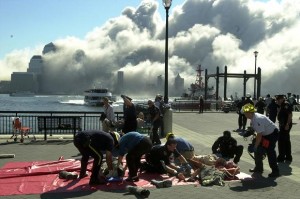 “It does for me, too,” I said. “But these specials also showed me some of the good that came from this horrible day.” I told her of the interviews with the survivors who have now become a huge family with the widows and children of the men who gave their lives. I reminded her of how much closer the people had become who worked together that day; the amazing stories of sacrifice and heroism by the people who were first on the scene, even across the river into New Jersey. “These people talked of the pain they felt that day, their feelings of helplessness and of running on adrenalin and going to extra mile for the injured. There is a stronger bond there,” I said. “A greater love of their co-workers and neighbors. A greater love of their fellow man. And love is good.”
“It does for me, too,” I said. “But these specials also showed me some of the good that came from this horrible day.” I told her of the interviews with the survivors who have now become a huge family with the widows and children of the men who gave their lives. I reminded her of how much closer the people had become who worked together that day; the amazing stories of sacrifice and heroism by the people who were first on the scene, even across the river into New Jersey. “These people talked of the pain they felt that day, their feelings of helplessness and of running on adrenalin and going to extra mile for the injured. There is a stronger bond there,” I said. “A greater love of their co-workers and neighbors. A greater love of their fellow man. And love is good.”
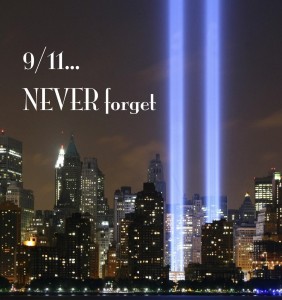 Tragedies on a global or national scale, or even in our personal lives, if viewed from the proper perspective, can give us all a chance to grow. No matter how old I get, the pain of loss is still agonizingly unbearable. But the essence of my being, who I really am, is a child of God imbued with His love. When I can live from that perspective, I am able to see the good in a horrible situation. It is healing for me. It is good for me.
Tragedies on a global or national scale, or even in our personal lives, if viewed from the proper perspective, can give us all a chance to grow. No matter how old I get, the pain of loss is still agonizingly unbearable. But the essence of my being, who I really am, is a child of God imbued with His love. When I can live from that perspective, I am able to see the good in a horrible situation. It is healing for me. It is good for me.
I invite you to pause a moment on the anniversary to remember the lives lost. It is my hope that you can also recall the good that came from that day and, for it, be grateful and have hope for humanity. It is up to me, to each of us, to decide if we want to live in Love or let our fears disguise who we are.


Excellent essay Bill. Thank you.
Thank you, Cherie!
Another beautifully written piece, Bill. I just knew I’d need Kleenex.
You’re right, I know exactly where I was and what I was doing on that early Tuesday morning and for the entire week that followed. I will never forget. To this day, anything I read or see regarding that tragic day brings tears to my eyes. Even through all the unbearable sadness and tears, one has to acknowledge all the good we saw emerge from such a horrific event. All the love, compassion, support and caring from total strangers trying to reach out and do anything they possibly could to help anyone in need was awe inspiring. It’s how it should be and what this world desperately needs more of on a daily basis.